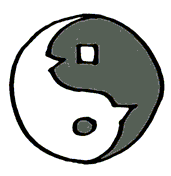

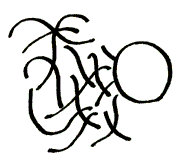
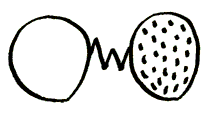
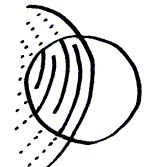
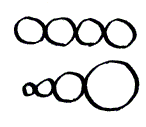
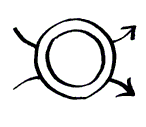
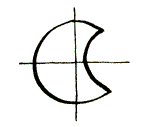
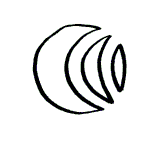
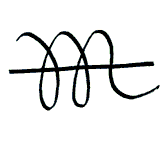
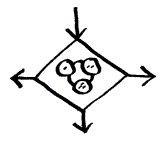
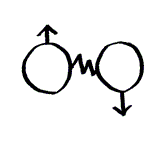
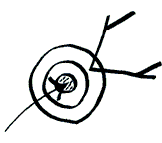
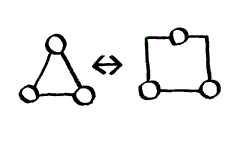
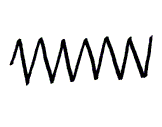
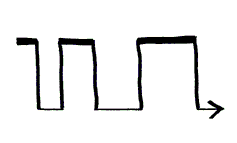
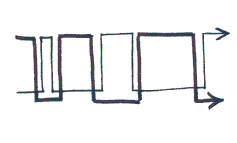
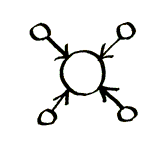
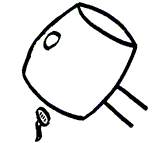
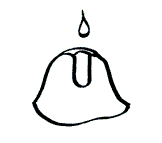
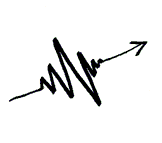
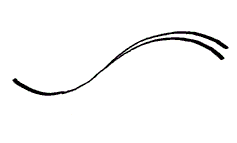
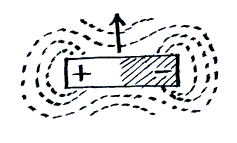
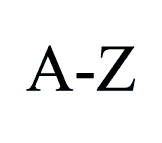
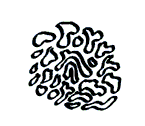

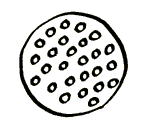
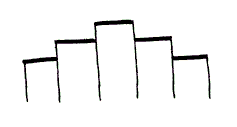
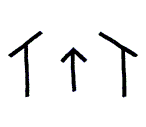
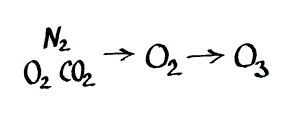
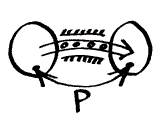
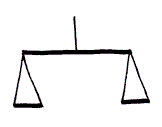
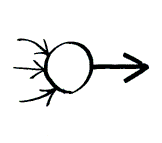
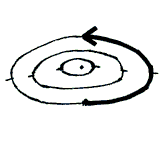
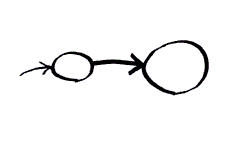
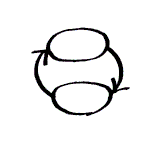
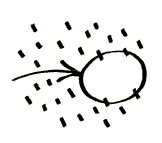
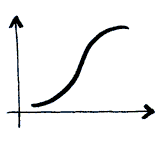
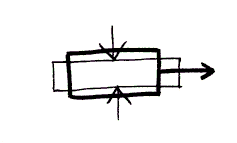
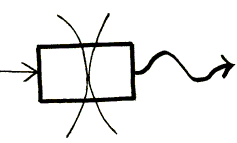
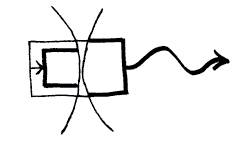
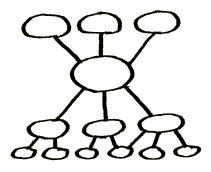
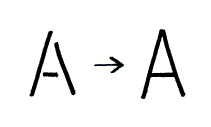
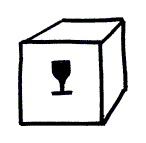
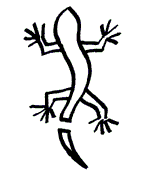
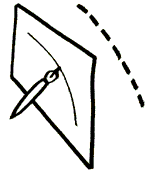
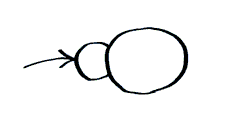
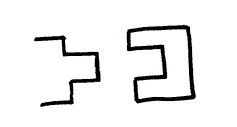
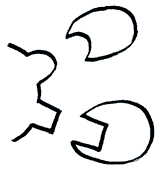
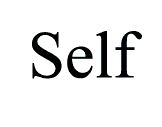
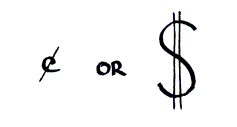
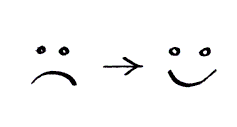
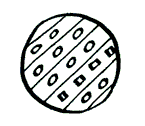
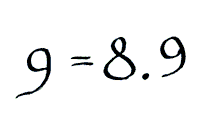
- Look for contradictions, conflicting elements, etc. That is where the cause of the problem is;
- Strive for an Ideal Solution: "The problem is solved by the means already present without any additional harm";
- Use available resources: present in the system, in surroundings, in media, and ones that are cheap;
- Self service! Formula: "The object ITSELF solves the problem";
- Any interaction means there is a flow of something. Keep it in mind. Abstraction includes flows of "coordinates", "deformations", etc. Anything which changes. And if there is an interaction (or an abstract flow), there is a cause of it (called "abstract potential"). 70% of all problems deal with flows.
1. The methods are applied either alone or in combinations:
Most problems are solved with structure or scenarios of multitude of methods.
Let us talk a bit about synthesis. A method can be used, then its anti- or opposite method can be used. Then you may come to the idea of combination of a method and its anti-method to find a more powerful solution. The combination may be achieved with any other method.
2. During the system analysis of a problem, you will come to two actors: "A Tool", what acts, and "A Product", what is act upon. To solve the problem you can apply the same principle to either one. This doubles your choices.
* * *
This collection of methods and principles is a cumulative effort of many generations of problem solvers. IT DOES WORK!
Negation or "The Other Way Around" |
Negation, or "Do the opposite", - Negation of Negation, or Constancy; Method 1 [13] |
||
| Constancy, continuation, perseverance; | |||
Extraction
|
Extraction - Application; Method 2 [2] |
||
Segmentation
|
Segmentation - Unification; Method 3 [1] |
||
| Local Quality
A). Transition from homogenous to heterogeneous system structure of the object, or its environment, or external influence. (It is related to the content, or topology, or the rules of the system); B). Different parts of the object should carry different functions; C). Every part of the system must be in conditions which are the most favorable for its functioning Uniformity A). An example: a rough terrain (a system with varying "local qualities") is flattened by passing animals, carriages, or rollers and turned into a trail or a dirt road |
Local Quality - Uniformity; Method 4 [3] |
||
| Consolidation
A). Unify the objects of similar kind or intended for contiguous operations; B). Unify in time operations, actions which are similar or contiguous; C). Unify the objects or methods of simiar purpose but opposite nature, or opposite purpose but similar nature (unification of two opposites); D). Unify in time operatioins of actions which are opposite. Separation A). Separate the objects of the same class or performing similar operations. Make them be or act somewhat differently; B). Separate in time operations, actions of the same class or those which are contiguous. Make them somewhat different; C). Separate the objects of the same class or performing opposite operations. Make them be or act totally differently, but keep together in some way; D). Separate in time operations, actions of the same class or those which are contiguous. Make them opposite. |
Consolidation - Separation; Method 5 [5] |
||
| Multifunctionality
A). An object serves several different functions so the need for other objects is eliminated. Unifunctionality A). Make an object highly specialized in one or several corresponding functions. Prevent its use for anything else; B). Different objects perform the same function. |
Multifunctionality and Unifunctionality; Method 6 [6] |
||
| Asymmetry
A). Convert from symmetrical form to asymmetrical; B) If the object is asymmetrical, increase asymmetry. Symmetry A). Transforming from asymmetrical form to symmetrical. |
Asymmetry and Symmetry; Method 7 [4] |
||
| Nesting
A). One object is placed inside another which, in turn, can be placed inside a third one; B). One object is passed through the cavities of another. Filling A). All cavities are filled with a single object. Original object becomes its cavity. |
Nesting and Filling; Method 8 [7] |
||
| Spheres and Curves
A). Go from straight parts to curved ones, from flat surfaces to spherical ones, from cube and parallelepiped parts to ball structures; B). Use rollers, balls, spirals (small parts); C). Go from linear motion to a rotary one, use centrifugal force. Straight Lines and Flat Surfaces 0) Use only objects with straight angles; A) Use straight lines and flat surfaces; B) Use angled small particles; C) Use linear motion, the more precise the better. |
Spheres, Straight Lines, and Flat Surfaces Curves; Method 9 [14] |
||
| State Machine
A). If a system has at least two functional states, define them explicitly (it means assign "a system" to each of the states); B). If states are somewhat "diluted" by each other, make them clearly separated; C). Make the states stable, so that an unwanted transition force or noise cannot make the change. It will also simplify the transition process; D). Make the transitions to be states too. Mess |
State Machine - Mess ; Method 10 {101} |
||
| Dynamism A). Parameters of an object or the environment must be altered to be optimal at each stage of operation; B). Divide an object into parts capable of moving in relation to each other; C). If an object is not moving in general, make it move, displaceable. Crystallization A). Make everything static and solid. Crystallize. Insulate. |
Dynamism and Crystallization; Method 11 [15] |
||
| Partial or Excessive Action
A). If it is difficult to obtain 100% of a desired effect, achieve more or less. It becomes much simpler to solve the problem. Excess can be removed or amended. Often it is easy or unnecessary. Utmost Precision |
Partial or Excessive Action vs Utmost Precision; Method 12 [16] |
||
| Transition into Another Dimension and Topology
A). Difficulties, related to movement (or location) of an object in line are solved, if the object obtains an opportunity to move in two dimensions (i.e. in plane); Correspondingly, the problems related to movement (or location) of objects in a plane are solved with a transition to the space of three dimensions; B). Use a multi-level composition of objects instead of a single-level one. "Many planes"; C). Incline an object or place it "on its side". "Relocating a plane" (out of orthogonal ways into incline ways). It means out of familiar topology (road) to a new one; D). Use the opposite side of a given surface. (A plane has two sides!); E). Use optical flows, falling on the neighboring area or on the opposite side of the existing area; F). Use transition to another space (and back), from one coordinate system to another; G). Use another structural presentation, i.e. topology, change the order of elements, combination. Itself is an Opposite A). Go from many dimensions to fewer ones. For example: making a film, a foil; B). Use "fewer planes"; C). Make it to the predefined, standard, customary topology. For example: make everything orthogonal; D). Use only one side of the surface (and use the other side for something else). |
Transition into Another Dimension and Topology; Method 13 [17] |
||
| Vibrations
A). Place an object into an oscillating movement; B). If such movement is already going on, increase its frequency (up to ultrasonic); C). Use the resonance frequency; D). Use piezo vibrators instead of mechanical vibrators; E). Use ultrasound vibrations in conjunction with electromagnetic fields; F). Use interference and diffraction. Eliminating any Vibrations A). "Smooth as silk". "Cold solid" |
Vibrations; Method 14 [18] |
||
| Periodic Action A). Change over from continuous action to a periodic one or impulse one; B). If the action is already periodic, change its periodicity; C). Use pauses between impulses for another action. Continuous Action A). Change to continuous action, continue no matter what; B.1). Change periodic action to the action with very long period, and used the "action" half; B.2). Change periodic action to the action with very short period, changing very quickly (see Vibrations principle), so that the action feels like continuous; C). Use pauses between impulses for the same action. |
Periodic Action; Method 15 [19] |
||
| Continuity of Useful ActionS (Perfect Timing)
A). Carry out the operation continuously (all object parts should work all the time with full load achieving synchronization of cumulative action); B). Eliminate idling and intermediates; C). Continuity is often achieved by going to rotation (see Method 9 [14]). Discontinuity A). Divide the continuous action into intervals with the intermediate useful result; B). Do not plan to unify two processes into one continuous, if at the point of connection there arise difficulties which are hard to handle. |
Continuity of Useful Actions (Perfect Timing); Method 16 [20] |
||
| Cumulative Action
Cumulative Action may be achieved by many systems A) acting simultaneously or B) it may be a set of sequential actions. Disperse A). Disperse, spread actions in space and time |
Cumulative Action or Disperse; Method 17 [42] |
||
| Superpower
A). Conduct action with the maximal power obtainable;
|
Superpower; Method 18 {102} |
||
Micropower |
Micropower; Method 18 {102} |
||
| Rushing Through A). Carry out the operation or some of its stages (for example, harmful or dangerous) with high speed; B). Use impulse. |
Rushing Through; Method 19 [21] |
||
| Invisibly Slow
A). Use a very slow action so it becomes unnoticed. |
Invisibly Slow; Method 19 [21] |
||
| Polysystems and Continuous Systems
Former formula: A). Replace a mechanical system with an optical, acoustic or olfactory(smell) one; B). Use electrical, magnetic, or electro-magnetic fields to interact with an object; C). Go from stationary fields to moving, from fixed to changing in time, from unstructured or uniform to structured; D). Use fields in conjunction with field-activated (like ferromagnetic) particles. New formula: A) Replace a system with few elements and of higher level with system of more simple elements and at a lower level, a polysystem, a field, a continuous polysystem; B). Use fields which are more controllable and powerful; C). Dynamize the field, structurize it; D). Use Junctions as systems which react and interact with different worlds. |
Polysystems and Continuous Systems; Method 20 [28] |
||
| Completeness A). What is analogous to continuity in the world of discrete systems? Completeness. No gaps. Everything is covered. All possible and required elements are present.; B). When a system is "complete", new properties (quality) appear "for free". It is especially true when the system is a collection of components which work together in some way. Incompleteness A). Make the thing incomplete, so that it can be amended; B). Make things incomplate to remove extra quality. |
Completeness; Method 21 {103} |
||
| "Pneumatics and Hydraulics"
A). Instead of solid parts, use gaseous or liquid ones: inflatable, filled with water, airbags, hydrostatic or hydrodynamic ones, and so on". |
"Pneumatics and Hydraulics"; Method 22 [29] |
||
| "Flexible Membranes or Thin Films"
A). Instead of ordinary designs, use flexible membranes and thin films; B). Isolate an object from the system environment with flexible membranes or thin films; C). Use naturally occurring films as boundaries between systems; D). Use polysystems of "boundaries". Eliminate Boundaries, Barriers, Insulators Example. What are films in computer software systems? It is interface functions and classes... |
"Flexible Membranes or Thin Films"; Method 23 [30] |
||
| "Porous Materials"
A). Implement a porous object or use additional porous elements (inserts, coating); B). If an object is already implemented as porous, fill it with some substance. [Not necessarily "up".] |
"Porous Materials"; | ||
| "Changing Color" or "Dividing into Bins"
Former formula: A). Change the color of an object or the "External Environment"; B). Change the degree of transparency of an object or the "External Environment"; C). For the purpose of observation of poorly visible objects or processes, use colorizing additives; D). If such additives are already applied, employ luminophores and the like. New: This is not about color per se. This is about anything " divided into bins ", into categories, ranges, intervals.. |
"Changing Color" or "Dividing into Bins"; Method 25 [32] |
||
| Hi-Precision(the Subprinciple of [32] ); Low Precision |
Hi- and Low Precision; Method 26 {104} |
||
| "Strong Oxidizers" Former formula: A). Replace regular air with an enriched one; B). Replace enriched air with oxygen; C). Affect the air or oxygen with ionized radiation; D). Use ozoned oxygen; E). Replace ozoned (or ionized) oxygen with ozone . New formula: A) Replace a system with a more productive or active one. Increase concentration of the active system; B) Get rid of lumber leaving only the active system; C) Activate the active system more with some activation agent; D) Use a mix of an active system and a super-active system; E) Use only a super-active system. |
"Strong Oxidizers"; Method 27 [38] |
||
| Flows
A). In order to introduce new properties in a system, including its growth and destruction, organize or control a flow of some systems either into it or from it. |
Flows; Method 28 {105} |
||
| Balancing (Counterweight) A). Compensate for the weight of an object by combining with another object that possesses a lifting force; B). Compensate for the weight of an object via interaction with its environment (for example, with aero- and hydro-dynamic forces); C). Compensate any action with an opposing action, especially those which are obtainable within its environment; D). Make two parts equal in some way. May be dynamically. Unbalancing |
Balancing (Counterweight); Method 29 [8] |
||
| Counteraction (Reserves)
A). Make preliminary tension in an object, opposite to unacceptable or unwanted working stress; B). If a problem requires some action to be carried out, make the counteraction in advance; C). If a parameter varies around a working value and must not exceed a limit, lower the working value and vice versa; D). Accumulate reserves. Depleting Reserves |
Counteraction (Reserves); Method 30 [9] |
||
| Equipotentiality or "Intersections of Polysystems"
A). "Change the conditions of the work in such a way that it does not require the lifting or lowering of an object".. Or almost; B). An intersection of polysystems produces a subspace with specific properties. |
Equipotentiality or "Intersections of Polysystems"; Method 31 [12] |
||
| Indirect Action
A). If it is not possible to affect a system directly, use indirect action; B). To gain an advantage or build a complex system use a chain of indirect actions. Direct Action A). Avoid any intermediates, approach directly. |
Indirect Action; Method 32 {106} |
||
| Feedback
A). Introduce feedback loop; B). If feedback exists, change it. This can be obtained by many means including changing the parameters of the involved systems. See other principles. Negative feedback can be turned into positive and vice versa. The Opposite A). Break feedback loop. Use other methods to do it. |
Feedback; Method 33 [23] |
||
| Inert Environment
A). Replace the environment with an "inert" environment; B). Introduce a neutral thing into an object; C). Conduct the process in a vacuum. Catalyst A). Replace the environment with a supporting one; B). Introduce a "catalyst" into an object; C). Enable supporting interactions. |
Inert Environment - Catalyst; Method 34 [39] |
||
| Change of Parameters
(Physical, Chemical, Structural, etc.) A). Change the aggregate state ( state of matter , "phase") of the object including intermediate states (like elastic solid bodies) and pseudo states ( non-newtonian fluids , shear thinning ); B). Change concentration or density; C). Change the degree of flexibility; D). Change temperature; E). Change the state of the system; F). Change the system so it becomes another system. |
Change of Parameters; This is the Method 35 [35] |
||
| "Thermal Expansion" (narrow formula) A). Use thermal expansion or compression; B). If already in use, use several materials with different coefficients of thermal expansion. C). General formula: A change of potential changes parameters of the system so that it produces an action or a flow. "Charging" A). A flow into a system changes its potential. Use it to affect other systems. |
"Thermal Expansion"; Method 36 [37] |
||
| Junctions
A). "Junctions" are transducers of energy, actions, influence, materials, information between different domains. They are transformations of one kind of a structure into another and, possibly, back. B). Junctions are systems. Apply the principles to Junctions. There are numerous effects related to them. Anti-Junctions A). Clean the world from Junctions |
Junctions, Transducers; Method 37 {107} |
||
| Affecting through Junctions A). To affect a world to which a junction connects, change properties of the junction in the other world. |
Affecting through Junctions; Method 38 {108} |
||
| Solving Problems on Upper and Lower Systematic Levels A). A new system property is introduced by changes in its compound-systems (supersystems) and the worlds they belong to; B). A new system property is introduced by changes in its subsystems and the worlds they belong to. Stay within the Level A). Confining operations to a certain system level can prevent negative effects which appear as the result of above. |
Solving Problems on Upper and Lower Systematic Levels; Method 39 {109} |
||
| Preliminary Action A). Perform required changes partially or completely in advance; B). Place the objects in advance so that they can go into action in a timely manner from the most convenient location. |
Preliminary Action; Method 41 [10] |
||
| Precaution Measures
("Cushion in Advance") A). Prevent malfunction or relatively low reliability of an object with emergency measures prepared in advance; B). If a system malfunctions or is destroyed, compensation can be provided by measures prepared in advance; C). Make "cushions" which allow small changes in the system without harm to other parts; D). Make parameters of the system to be regulated, adjustable; E). Make the system adaptable. |
Precaution Measures Method 42 [11] |
||
| Discarding and Regenerating
A). A part of an object which fulfilled, executed, performed, or carried out its purpose must be rejected (discarded, dissolved, evaporated, chemically removed, and so on) or modified immediately during the course of the system's functionality; B). Expendable parts of the object must be directly and/or continuously restored during the course of system's function. |
Discarding and Regenerating; Method 43 [34] |
||
| Copying (Modeling)
A). Instead of the system use a slightly different copy; B). Instead of the unavailable, complex, expensive, uncomfortable or fragile object, use its simplified and cheap copy; C). Replace an object or a system of objects with their optical copies (images). Use a change of scale (enlarged or reduced images); D). If an image in visible light is used, transit to infrared or ultraviolet images. E). Use "model" instead of "optical copy". It can be a mathematical model. Using Original A). Use the real system instead of any of its copies. No copy is completely the same as the original. |
Copying (Modeling) - Using Original; Method 44 [26] |
||
| Mediator
A). Use an intermediary object to transfer or carry-out an action; B). Temporarily connect the original object to one that is easily removed; C). Use an intermediary object to interrupt or prevent an action or a flow Immediate Contact A). Put objects into immediate contact eliminating any intermediates; B). "Clean the contacting surfaces" |
Mediator - Immediate Contact; Method 45 [24] |
||
Homogeneity |
Homogeneity; Method 46 [33] |
||
| Heterogeneity
A). A given system acting upon multiple different systems should do so in their own special way. |
Heterogeneity; Method 46 [33] |
||
| Self-Service
A). An object must service itself and carry-out supplementary and repair operations; B). Make use of waste (of energy or material) of the object. Delegation A). An object creates or is surrounded (systematically) with a surrounding system which does everything for the object; B). An object consumes and uses surrounding waste, materials, time, values not giving anything in return. |
Self-Service - Delegation; Method 47 [25] |
||
| Cheap non-Longevity Instead of Expensive Longevity
A). Replace an expensive object with a set of cheap objects, giving up some properties, for example, longevity. Grand A). Instead of multitude of cheap objects, make one grand |
Cheap non-Longevity Instead of Expensive Longevity; Method 48 [27] |
||
| Putting Harm into Use
A). Use harmful factors, (in particularly, harmful action of the system environment) to obtain a positive effect; B). Eliminate a harmful factor by adding, combining, convolving with other harmful factors or by diverting it; C). Amplify a harmful factor to such an extent, that it ceases to be harmful; D). During research, often undesirable phenomena are found which can even halt the research. This phenomena can be put into practice by using what it does. Examples are numerous: "discovery by accident, chance"; E). "Admit what seems as inadmissible. Let it happen!", and use it. Ignore Harm |
Putting Harm into Use - Ignore; |
||
| Application of Composites (Metamaterial)
A). Go from homogeneous systems to composite ones. Purity A). Go from composite or dirty systems to homogeneous or clean ones. |
Application of Composites (Metamaterial) - Purity; Method 50 [40] |
||
| Changing the Rules
"If a gentleman cannot solve a problem, the gentleman is changing the rules". |
Change the Rules; |
A system, by definition, is a whole which is more than its parts. It means, a system possesses a property which is absent in its parts. When a system is formed a property appear. That is what inventors do: they look for new properties and, as the case may be, elimination of a property. How to put parts together so that a new property appear? There are many ways. This list of methods which is developed by analyzing inventions tells you what can be used.
* * *
As published in "Junctions. On How Worlds are Connected", by Igor Polkovnikov, 2018. Please, give your feedback.
Copyright©2018-2021 Igor Polkovnikov